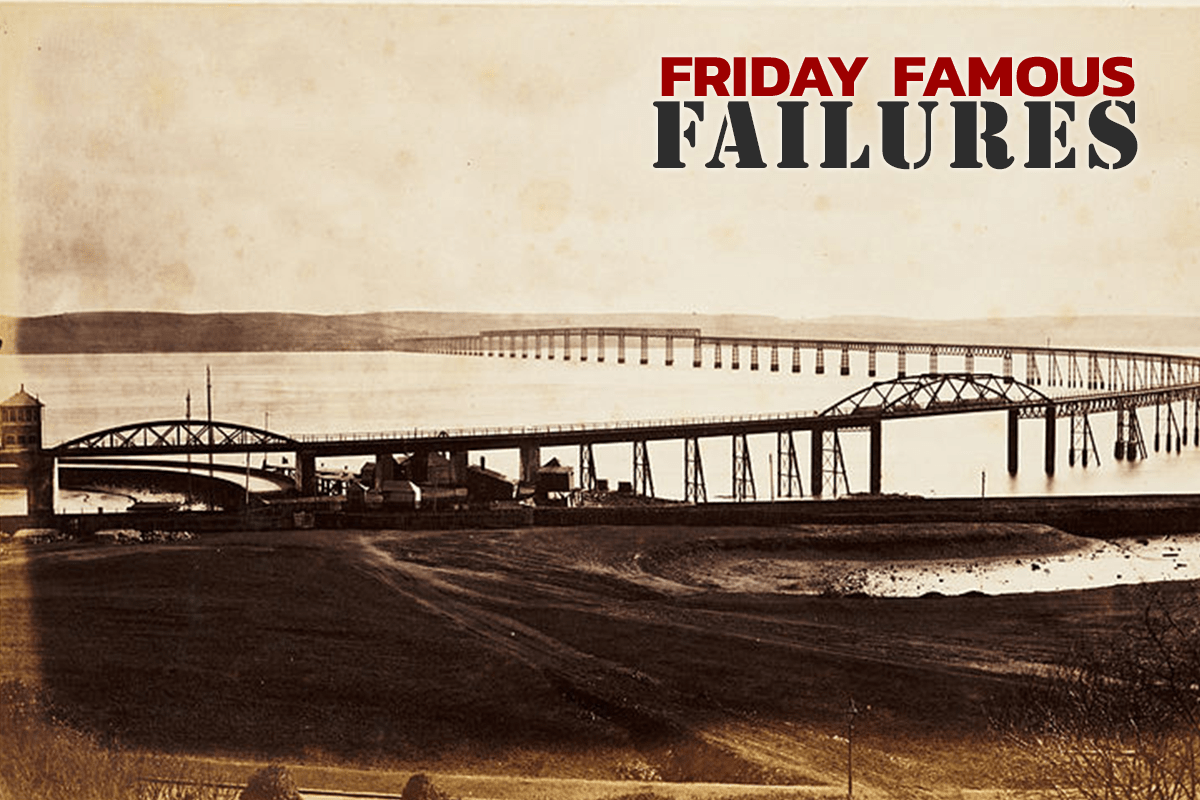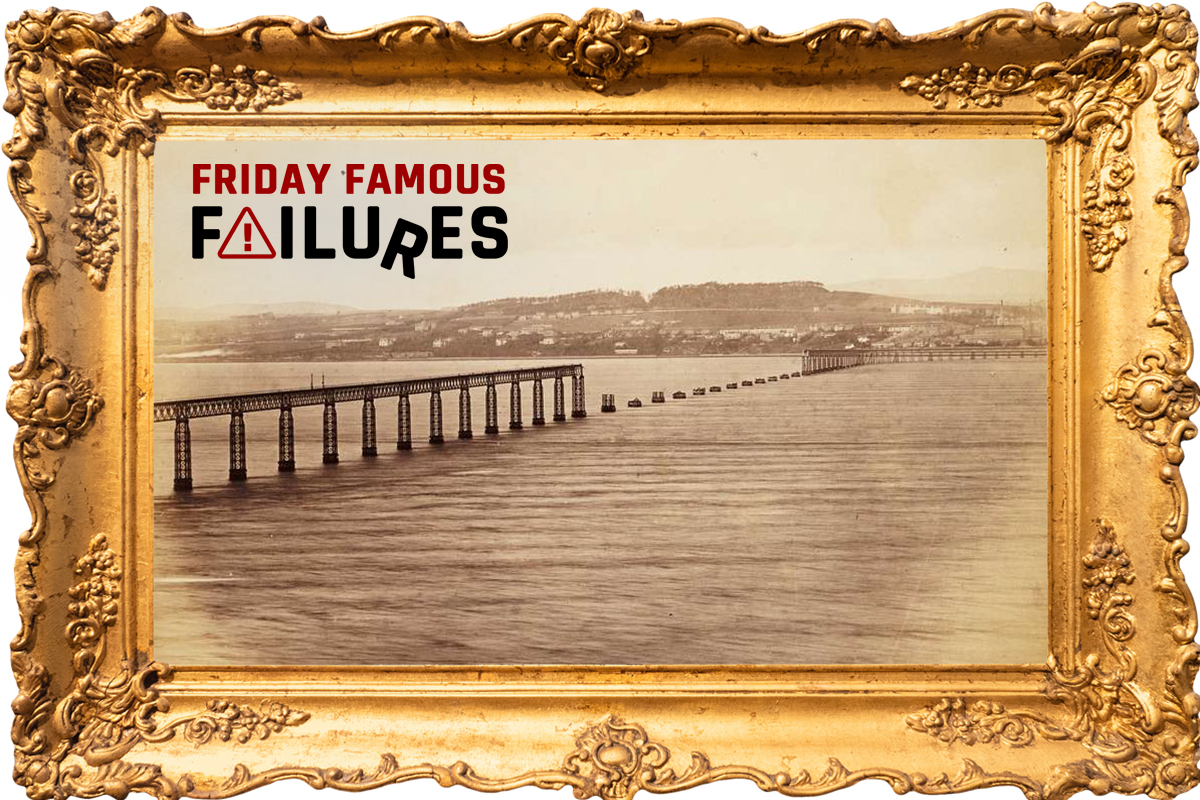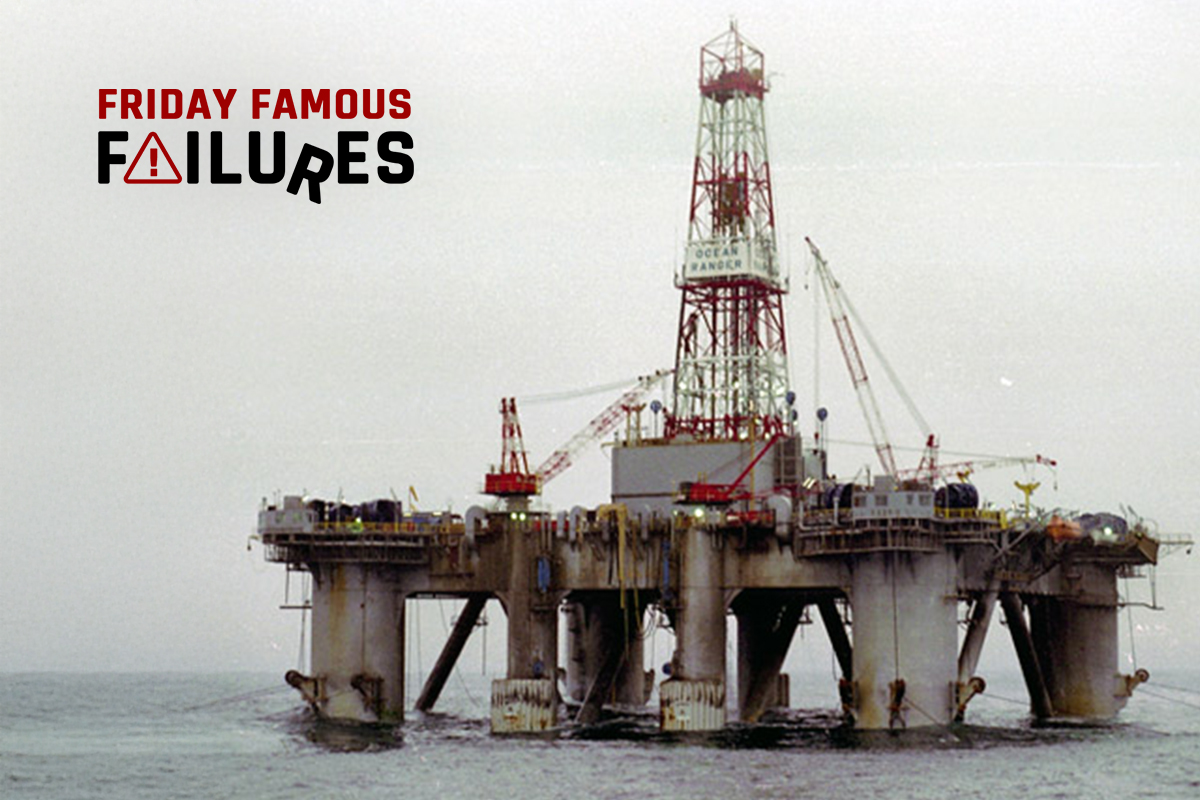In the late 1800s, when railroads were beginning to connect every corner of the United Kingdom, the National Board of Railroads commissioned a bridge over the Firth of Tay. This bridge was to have a high span so that sailing ships plying between the UK and Australia could pass beneath on their way in and out of the firth. The engineer Thomas Bouch designed a lattice-girder bridge supported on high iron piers and oversaw the construction. After the bridge was completed in September 1879, the Queen of England herself rode a train across it and bestowed a knighthood on Bouch in recognition of his engineering achievement.
But on December 28, 1879, during a violent storm, a late train driving from Burntisland to Dundee in Scotland was lost. When the storm abated, rescuers found the entire high span of the bridge had fallen off the piers while the train was crossing, claiming 75 lives. What had gone wrong with the bridge?
What caused this disaster?
Poor joining of girders. After the disaster, many engineers evaluated the Tay Bridge. They found that many flanges on the connecting girders were not fully faced (or machined), so they didn’t connect snugly. They also found that the cast girders had conical bolt holes which failed at much lower shear loads than would a cylindrical bolt hole. The consensus opinion was that the bolt holes should have been reamed (punched through to make them cylindrical) after casting.
Poorly designed materials. Engineering inquiries after the disaster discovered that many of the bolts and cotter pins used to connect the iron structural members were too small or not properly installed. The appointed bridge maintainer, Henry Noble, noted while checking the bridge foundations that many of the tie bars were “chattering” as a result of these defects. He assumed that the cotters were not driven in fully (a mistake in construction) and so began re-tensioning the tie bars with an additional packing piece. At the time of the disaster, Noble had only re-tensioned about 100 of the over 4,000 gib and cotter joints present on the bridge.
Poorly manufactured materials. While the iron quality was re-tested and found to be adequate after the disaster, there were significant problems in the manufacture of the iron columns, which made up the bridge piers. Sectioning of the columns showed uneven wall thickness, caused when a casting core moves during the pouring of hot metal. Some columns were as much as 0.5 inches out (i.e., the column wall was 0.25 inches thicker on one side and 0.25 inches thinner on the other). Where thinner walls occurred, many columns had a casting defect known as a “cold shut,” where the metal freezes before knitting together and leaves a crack in the material of the casting.
Oscillation of the bridge when in use. A local official, William Robertson, had a season ticket between Dundee and Newport and had noticed perceptible vibration laterally and vertically when trains on which he was traveling traversed the high span of the bridge, which he reported to the stationmaster at Dundee repeatedly. The vibration was noticed by other passengers, who estimated it at between a half an inch and 2-3 inches.
A violent storm blowing against the bridge. On the night of the disaster, the violent storm was blowing wind at right angles to the bridge structure. Some locals said the storm was as bad as any they had ever seen in the area, and one compared it to a typhoon he’d experienced years before in the South China Sea. At nearby Glasgow, the wind was measured at 71 mph. The estimated side-force on the bridge was over 50 pounds per square foot; the bridge had been designed for only 20 pounds per square foot.
Effects of the disaster
One of the signalmen controlling traffic to the bridge on the night of the disaster reported that “there was a sudden flash of light, and in an instant, there was total darkness, the tail lamps of the train, the sparks and the flash of light … all disappearing at the same instant.” When rescuers could get to the bridge the following day, they found the high span, and the train had fallen in the river. Later, divers found that the train was still within the steel structure of the high span, lying upon the floor of the river.
The inquiry into the disaster was highly publicized and very formal, with a qualified engineer giving his opinion as an expert witness that the Tay Bridge was poorly designed and poorly built; the lawyer for Sir Thomas Bouch maintained that a train had derailed in the high span due to high winds and struck the side of the high span, causing it to fall.
The expert witness engineer reported that the disposition of the wreckage indicated that the bridge had broken up before it fell off the piers and that the damage was not due to the impact of the bridge with the water or the bottom of the river. He pointed out the oscillation and vibrations noted by train riders and the evidence of the bridge maintainer, Henry Noble, that the structural elements were poorly joined. In blaming the workmanship, the engineer declared to the court:
I consider that in such a structure, the thickness of the columns should have been determined, every individual column should have been examined … I consider that every bolt should have been a steady pin, and should have fitted the holes to which it was applied, that every strut should have had a firm abutment, that the joints of the columns should have been incapable of movement, and that the parts should have been accurately fitted together, storey by storey upon land and carefully marked and put together again as they had been properly fitted.
The court did not reach a consensus, and instead produced a majority report and a minority report. The three court members did agree that the workmanship was inferior, the design of the bridge was insufficient to resist heavy gales, the manufacture of components was defective, the post-completion maintenance was deficient, and the speed limit of trains was not enforced. The majority report noted that there was no regulation on wind loading design consideration for bridges, and recommended that such a regulation should be passed. The minority report assigned blame to many parties, including the bridge engineer, the maintainer, and the foundry managers who had produced the bridge components.
As a result of the Tay Bridge Disaster, the Board of Trade established a five-man commission to establish the wind-loading design criteria for all major structures. This commission recommended that all major structures be designed to withstand wind loading of 56 pounds per square foot, with a safety factor of four. This became the standard for civil engineering throughout the United Kingdom.
In 1887, a new double-track Tay Bridge was built just upstream and parallel to the original bridge, which still stands today.









This took place before Young’s Modulus was accepted engineering science. The wonder is not that the Tay Bridge collapsed, but that more bridges did NOT collapse. As a historical note, Hook’s Law (essentially a version of Young’s theory) was proposed circa 1600. However, Sir Isaac Newton hated Hook. Issac was a Puritanical Prude and Hook was a rounder of reknown. Newton spent much time dismissing everything Hook proposed. Since Hook died somewhat earlier than Newton, Newton was able to get Hook’s science and research discredited. This was not unusual prior to about 1900. In another infamous case, Boltzman and Maxwell argued viciously over the value of the constant for radiative heat transfer. The argument was about the correct number in the 4th decimal place. The disagreement and dirty politics was so intense that Boltzman committed suicide. Boltzman, by the way, was correct.